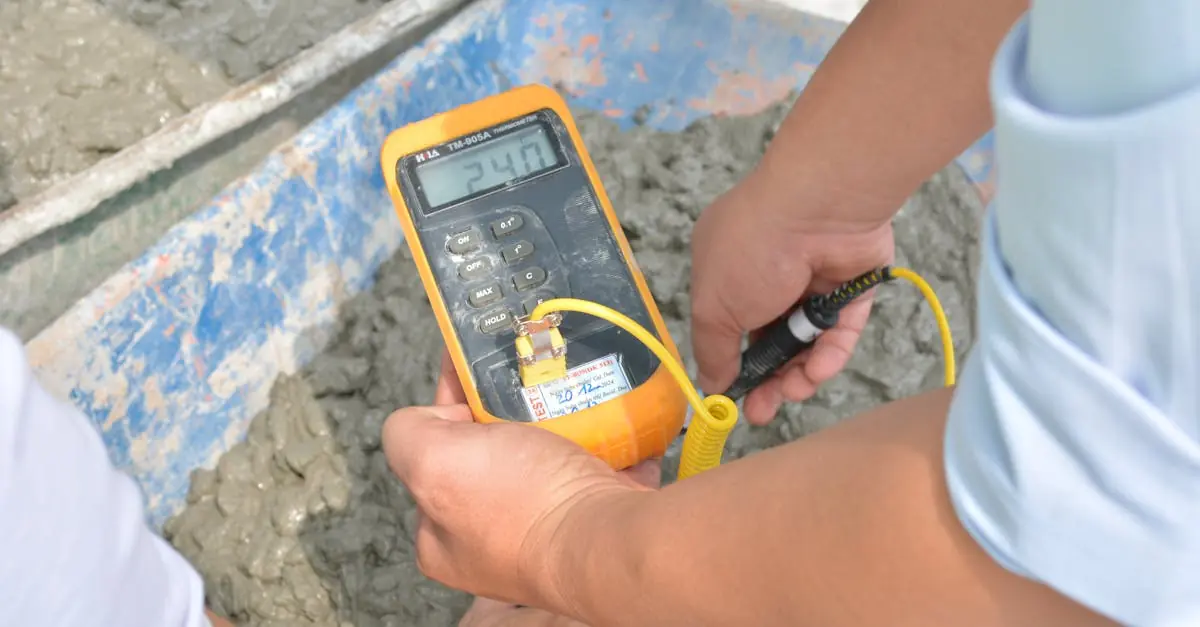Concrete isn’t just for sidewalks and foundations anymore. It’s the unsung hero of the DIY world, waiting to transform your home into a masterpiece. With a little creativity and a dash of elbow grease, anyone can turn plain old concrete into stunning decor that’ll make neighbors green with envy. Who knew mixing cement could lead to such artistic endeavors?
Table of Contents
ToggleOverview of DIY Concrete Projects
DIY concrete projects offer a unique way to enhance home decor and landscaping. Creativity shines through as concrete transforms into functional art pieces.
Benefits of DIY Concrete Projects
DIY concrete projects provide numerous advantages. First, cost-effectiveness stands out; concrete is often more affordable than traditional materials. Second, durability ensures that creations withstand various weather conditions. Third, customization allows individuals to express personal style through colors and shapes. Flexibility in design means options from garden sculptures to indoor planters. Furthermore, engaging in these projects fosters a sense of accomplishment and creativity.
Popular Types of DIY Concrete Projects
Various DIY concrete projects have gained popularity among enthusiasts. Creating concrete planters lets individuals design unique homes for plants. Molds can produce beautiful and intricate shapes. Handcrafted concrete table tops offer stylish additions to outdoor furniture. Additionally, stepping stones enable personalization of garden pathways. Concrete coasters provide practical items for home use while showcasing artistic flair. Each project invites creativity and enhances surrounding spaces.
Materials and Tools Required
A variety of materials and tools enhance the process of DIY concrete projects. Choosing the right equipment guarantees smoother completion and better results.
Essential Tools for Concrete Work
A shovel helps with mixing and pouring concrete. Buckets or mixing containers provide a space for combining materials. A trowel achieves a smooth finish on surfaces. For precise measurements, a measuring cup is essential. Additionally, gloves protect hands from cement. Using a concrete mixer or mixing paddle makes mixing more efficient. A level ensures even surfaces in projects. Finally, a mold or form shapes the concrete into desired designs.
Recommended Concrete Mixes
Standard concrete mix offers durability and strength for most projects. A fast-setting mix facilitates quicker completion for time-sensitive tasks. Lightweight concrete is ideal for creating less bulky items. Specialty mixes, such as decorative or high-strength formulas, provide enhanced aesthetics or performance. Ready-mix concrete simplifies the process by eliminating the need for onsite mixing. Finally, adding a concrete additive can increase workability and improve performance, tailoring the mix for specific requirements.
Step-by-Step Guide to a Simple DIY Concrete Project
This guide outlines essential steps for completing a simple DIY concrete project. Following these instructions ensures a smooth process and satisfying results.
Preparation and Planning
Begin by choosing a project that suits your skill level and space. Gather all necessary materials and tools for efficient workflow. Selecting a suitable mix, such as standard or fast-setting concrete, is crucial for project type. Measure the area where the concrete will be poured, ensuring accurate calculations. Create a detailed plan, including dimensions and desired design features. Using molds for specific shapes can enhance the final appearance. Prepare the workspace by ensuring it’s clean and free from debris to avoid complications during the mixing and pouring stages.
Mixing and Pouring Concrete
Mixing concrete requires attention to detail for optimal consistency. First, follow the manufacturer’s instructions for water and mix ratios. Use a concrete mixer or a sturdy bucket for small quantities. Pour the dry mix into water gradually for even blending. Achieve a uniform texture that appears thick but workable. Next, quickly transfer the mixed concrete into molds, ensuring even distribution. Use a trowel to smooth the surface for a professional finish. After pouring, allow the concrete to settle and cure according to product specifications for durability and strength. Monitor the curing environment, especially humidity and temperature, for best results.
Advanced DIY Concrete Projects
Exploring advanced DIY concrete projects expands creativity and functionality. These projects push boundaries, transforming spaces with innovative designs.
Decorative Concrete Techniques
Textures and colors elevate decorative concrete techniques. Stamping concrete creates patterns resembling stone or tile, enhancing visual appeal. Staining offers vibrant hues that allow for unique finishes. Engraving adds intricate details, making each piece distinct. Adding aggregates can add interesting textures and colors. Using molds opens possibilities for custom shapes, whether for tabletops or garden ornaments. Each technique invites experimentation and personalization, resulting in stunning art pieces that impress.
Functional Concrete Projects
Functional concrete projects offer both utility and style. Building outdoor furniture, like benches or tables, combines aesthetics with practicality. Creating garden pathways ensures durability and ease of maintenance, while enhancing landscape design. Fire pits made from concrete provide a stylish, functional outdoor centerpiece. Crafting storage solutions, such as shelves or planters, maximizes space and utility. Incorporating lighting elements into concrete designs adds ambiance while serving practical purposes. Each project brings lasting benefits to homes and gardens, merging function with creativity.
Tips for Successful DIY Concrete Projects
Preparation plays a crucial role in achieving desired outcomes in DIY concrete projects. Start by selecting an appropriate project that aligns with your skills and resources. Gathering materials ahead of time ensures a smooth workflow.
Consistency remains vital in mixing concrete. Aim for a uniform texture before pouring. Use the recommended water-to-concrete ratio on the package instructions to avoid weak spots. Tools such as trowels and mixers help maintain that consistency.
Weather conditions significantly impact concrete projects. Complete outdoor work in moderate temperatures, ideally between 50°F and 85°F. Avoid extreme heat or cold, as they can adversely affect curing times.
Patience is essential during the pouring and curing phases. Pour concrete in manageable sections to form an even surface. Allow adequate curing time before disturbing your project, typically 24 to 48 hours for initial set and up to 28 days for full strength.
Think about aesthetics when designing your concrete projects. Incorporate decorative techniques like coloring or stamping after the pour. Utilize molds creatively to shape unique structures that enhance visual appeal.
Safety precautions should never be overlooked. Use gloves and masks while handling concrete to protect skin and lungs. Ensure proper ventilation, especially when mixing additives or chemicals.
Focus on functionality as well as beauty. Create multi-purpose items that serve practical purposes while enhancing decor. Functional art pieces, such as outdoor benches or planters, can transform spaces with style and utility.
Learning from others through online resources or community workshops can also benefit DIYers. Participate in forums or social media groups to exchange tips, ask questions, and share progress. Building a knowledge base provides inspiration and insight for future projects.
Embracing DIY concrete projects opens a world of creative possibilities. With a little effort and the right tools anyone can transform simple materials into stunning home decor and functional art. Whether crafting planters or outdoor furniture each project offers a unique opportunity for personalization and design.
The satisfaction derived from creating something beautiful and practical is unmatched. By exploring various techniques and styles DIY enthusiasts can continually push their creative boundaries. As they experiment with different mixes and decorative methods their skills will grow alongside their confidence.
In the end the journey of DIY concrete projects is as rewarding as the finished product. Every piece crafted tells a story and enhances the beauty of any space. So grab those tools and let creativity flow.




